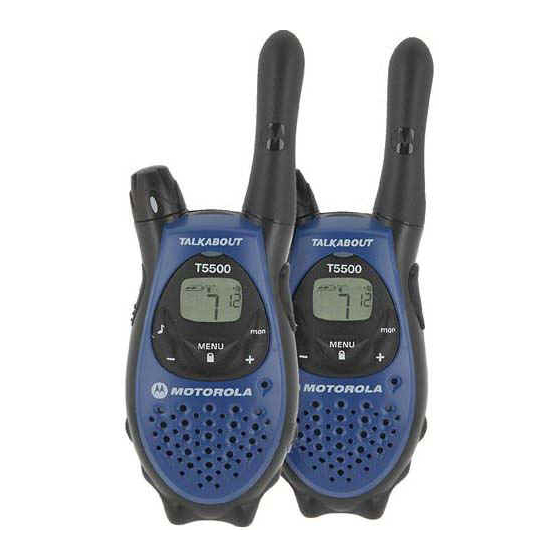Motorola TALKABOUT T5500 Manuale delle comunicazioni - Pagina 12
Sfoglia online o scarica il pdf Manuale delle comunicazioni per Radio Motorola TALKABOUT T5500. Motorola TALKABOUT T5500 16. Frs/gmrs recreational two-way radios
Anche per Motorola TALKABOUT T5500: Manuale d'uso (36 pagine), Manuale d'uso (17 pagine), Manuale d'uso (5 pagine)

common things that block UHF radio waves. Therefore the "ranges" given on the
packages of FRS/GMRS radios in stores are misleading. These ranges are determined
by using two stations both on elevated points with nothing in between. First of all, if
you do not have a GMRS radio license and need to use the lower power FRS radio,
you should not expect to get what is advertised because it is for the GMRS power
level. Also, the most important factor in getting a good transmission is to avoid
the obstructing objects just mentioned by moving around. Often that means
getting out from behind a structure, climbing a small hill or moving out of a very
leafy area to get a clearer "path" to the person you are trying to talk to. If you
are having trouble communicating both stations should try different locations and ask
for "readability" reports (1= not heard, 2=heard with difficulty, 3=little difficulty
understanding, 4=heard no difficulty, 5=perfectly understandable)...then go back to
where you got your best report.
2) Relaying
When one station is too far away to reach another station that you want to talk to, it is
possible to pass information by using a relay station. We expect to use this method in
ASNC CERT disaster communications. What is done is that a third station,
somewhere in the middle that can talk to and hear both of the first two stations,
receives messages and passes them back and forth. Often this relay station will be
located at a high point (hill or building) which can be seen by others at lower levels.
3) Pausing between transmissions
It is a good idea to pause for 2-3 seconds between all transmissions, particularly
during a disaster or disaster drill. This allows time for another station with emergent
traffic* to make that known. If you need to use an already occupied radio channel to
exchange a message which relates to preventing injury, death or property damage say
quickly between transmissions: " your tactical call with emergency traffic." This
means that you need the channel immediately to pass time sensitive information..
Also, waiting before starting to talk allows you to hear if you are "doubling" with
someone (see 3 above) and allows someone to join in to conversation if they need to.
6) Disaster Drills
During disaster drills you should state "this is a drill" every 5-10 minutes. Remember
that anyone with a FRS/GMRS radio or scanner can hear what you are saying. If the
CERT group is practicing in an exercise with a "mock" disaster scenario, someone
listening in might become frightened and even go to the police, or a radio or TV
station to report a "disaster". Frequently saying "this is a drill" can avoid this kind of
panic.
7) Passing messages and tactical call signs
Passing information between radio stations, also called message (or traffic)
handling, is the main function of radio communications during an emergency. To
help know who is talking to whom each functional disaster unit will be assigned a
12
For disaster communication in the ASNC area, tune to FRS Channel 2 (Alternate: Ch 12)
Ham Radio Operators should also tune to Battalion 2 simplex 145.585 MHz, PL 110.9
